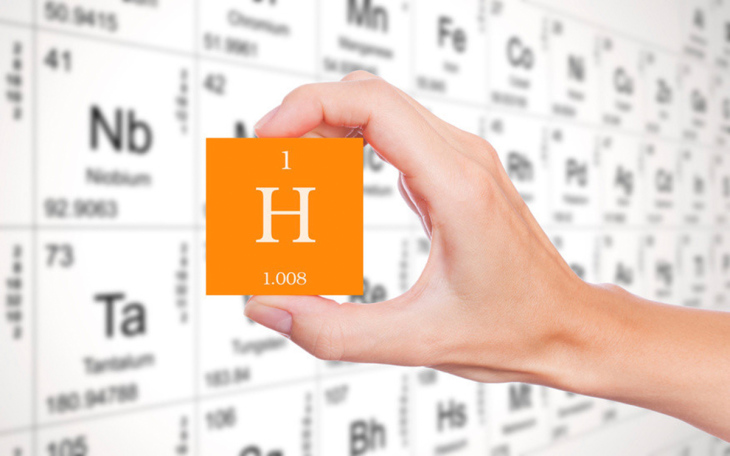Hydrogen Refuelling Now Five Times Faster
Scientists at the Helmholtz-Zentrum Geesthacht develop a new concept
Hydrogen is a clean fuel for vehicles, but storing hydrogen still faces many challenges. Material researchers at the Helmholtz-Zentrum Geesthacht, Centre for Materials and Coastal Research (HZG) are developing hydrogen storage systems based on light metal hydrides. They have now published a new concept in the scientific journal Nature Scientific Reports, by which these systems can for the first time be refilled five times faster at a working temperature of less than 180 degrees.

A hydrogen fuelling station in the city of Hamburg: Amide-hydride based solid storage tanks could become an alternative to pressurised gas tanks. This is the subject of research by scientists at the HZG.
Foto: ©hadrian_ifeelstock/AdobeStock
Hydrogen presents the perfect solution for CO2-neutral mobility, if, for example, the gas is produced with electricity from wind power. With hydrogen in the tank, not a single gram of carbon dioxide is produced; only water vapour. One of the limiting factors in the utilization of hydrogen is the lack of an efficient storage system. In current fuel cell cars, hydrogen is filled into pressurised gas tanks at pressures of up to 700 bar, which is expensive and technically demanding. Amide-hydride based solid storage tanks present a highly promising alternative.
So-called magnesium hydride has been studied as potential hydrogen storage systems by the Helmholtz-Zentrum Geesthacht for several years. The advantage over conventional pressure tanks: they can store more hydrogen per unit volume, and thereby more energy. An example: five kilograms of hydrogen will allow a fuel cell car to drive approximately 500 km. A high-pressure tank would require a volume of 122 litres to hold five kg of hydrogen, while a tank based on magnesium hydride would need to have a volume of 46 litres. However, filling it would require high temperatures of around 300 degrees Celsius.
Potassium and titanate were milled to tiny nanoparticles

The scientists have developed a new hydride composite system that can be loaded very quickly at low working temperatures of below 180 degrees. Picture: concept w/Fotolia
To lower this temperature, researchers use additives such as potassium. Claudio Pistidda, a materials researcher in the “Nanotechnology” department at the Helmholtz-Zentrum Geesthacht, and one of the authors of the current publications, explains: “Unfortunately, this often leads to drastic reduction of the system hydrogen capacity. We have therefore developed a new reactive hydride composite system with a high hydrogen storage capacity that can be filled and discharged very quickly at working temperatures under 180 degrees Celsius.”
For example, the fuelling process for Magnesium-Amide-based Hydrids would be around 30 minutes for five kilograms of hydrogen. HZG scientists have now successfully combined two additives in order to drastically reduce the time necessary for the filling and discharging of the systems potassium and lithium titanate. The scientists have used specialised mills to mill potassium and titanate together with Magnesium-Amide-based Hydrids into tiny nanoparticles. This massively increases the surface area of the individual particles, allowing them to bind more hydrogen.

HZG doctoral candidate Gökhan Gizer has carried out countless experiments for the study. After three years, he achieved his breakthrough: in the study, the researchers were able to demonstrate that the developed additive acts as a catalyst and accelerates the loading of hydrogen into the reactive hydride composite system. Gökhan Gizer explains: “We have invented a catalyst which allows the refuelling process to proceed about five times quicker.”
Generally, the charging and discharging of the metal hydride storage tank depend on the heat transfer, the movement of the gas through the hydride, as well as the rate of reaction with the hydride. Understanding these processes in detail forms the basis of the scientists’ research. Fundamental research with real added value: “the results of this study bring us a huge step closer to competitive storage tanks,” explains Dr. Pistidda.
The scientists in the “Nanotechnology” department are now working on optimising the reaction kinetics of these new materials in order to qualify them for the technical application in vehicles.
Publication:
Improved kinetic behaviour of Mg(NH2)2-2LiH doped with nanostructured Kmodified-LixTiyOz for hydrogen storage. Gökhan Gizer, Julián Puszkiel, Maria Victoria Castro Riglos, Claudio Pistidda, José Martín RamalloLópez, Martin Mizrahi, Antonio Santoru, Thomas Gemming, Jo-Chi Tseng, Thomas Klassen and Martin Dornheim. Scientific Reports (Nature)
Contact:
Helmholtz-Zentrum Geesthacht
